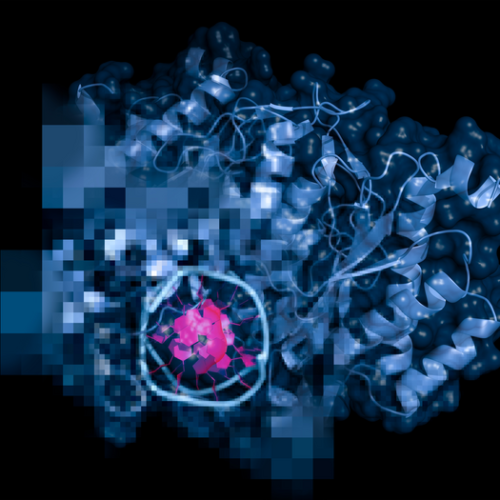by Johns Hopkins University School of Medicine Artistic rendition of diabetic eye disease highlighting vascular changes (i.e., retinal neovascularization) observed in patients with proliferative diabetic retinopathy. Credit: Isabella S. Sodhi, McDonogh School Researchers at Wilmer Eye Institute, Johns Hopkins Medicine say they have evidence that an experimental drug may prevent or slow vision loss in people with...
New method tracking changes in blood vessels could advance brain disease detection
by Brown University In stunning detail, Brown engineer Jonghwan Lee can use retinal scanning technology to image the vasculature of neural tissue. Credit: Jonghwan Lee While age-related brain disorders like Alzheimer’s disease often develop slowly across an individual’s lifetime, they usually aren’t detected until symptoms have already started. With that in mind, teams of biomedical researchers led by...
Investigating a schizophrenia drug as a new therapy against dementia
by Medizinische Hochschule Hannover Relying on a drug against schizophrenia in the fight against dementia: Professor Dr. Evgeni Ponimaskin and Dr. Josephine Labus Credit: Karin Kaiser / MHH A common feature of many neurodegenerative diseases are pathological protein deposits in the brain. These protein aggregates cause nerve cells to die and, as a result, entire...
Stretchable knee wearable offers insight into improving e-textiles for health care
by Singapore University of Technology and Design The smart fully knitted knee brace seamlessly integrates multiple flexible electrical components into a stretchable circuit. When worn, the knee brace converts changes in one’s knee joint to electrical signals, enabling the wireless and continuous real-time sensing of one’s knee joint motion. Credit: SUTD Mobility limitation is an initial...
Multiple sclerosis: Ultrastructural changes in brain tissue promote inflammatory processes
by Carmen Rotte, Max Planck Society Inflammation occurring in the normal-appearing white matter. (A) Luxol Fast Blue, (B) proteolipid protein, and (C) Kim1p stainings of the optic nerve shows no demyelination or reactive sites, other than from some nodules, with a scale bar of 400nm. (D) Amyloid precursor protein (APP)+ axonal fragments (E) were found in both...
AI predicts the function of enzymes
HEINRICH-HEINE UNIVERSITY DUESSELDORF IMAGE: THE AI-BASED ESP MODEL DEVELOPED AT HHU CAN BE USED TO PREDICT WHICH SUBSTRATES CAN BE CONVERTED BY ENZYMES. CREDIT: HHU – PAUL SCHWADERER / STOCK.ADOBE.COM – PETARG Enzymes are the molecule factories in biological cells. However, which basic molecular building blocks they use to assemble target molecules is often unknown and difficult...
A giant leap forward in wireless ultrasound monitoring for subjects in motion
UNIVERSITY OF CALIFORNIA – SAN DIEGO IMAGE: A WEARABLE ULTRASONIC-SYSTEM-ON-PATCH MOUNTED ON THE CHEST FOR MEASURING CARDIAC ACTIVITY. CREDIT: MUYANG LIN A team of engineers at the University of California San Diego has developed the first fully integrated wearable ultrasound system for deep-tissue monitoring, including for subjects on the go. It facilitates potentially life-saving cardiovascular...
A new map reveals the complicated world in which cells seek to repair damaged DNA
UNIVERSITY OF CALIFORNIA – SAN DIEGO IMAGE: AN ARTISTIC RENDERING OF THE CONCEPT OF DNA DAMAGE AND REPAIR. NUMEROUS DISEASES ARE LINKED TO OR CAUSED BY ALTERATIONS THAT AFFECT GENOMIC INTEGRITY AND THE ABILITY OF CELLS TO FUNCTION AND DIVIDE NORMALLY. A PROCESS CALLED DNA DAMAGE RESPONSE HAS EVOLVED TO REPAIR ERRORS AND MUTATIONS. RESEARCHERS...
TAp63: A new protein drug target for rheumatoid arthritis
Peer-Reviewed Publication CHIBA UNIVERSITY IMAGE: RESEARCHERS USED MURINE AND HUMAN CD4+ T CELL LINES TO STUDY THE INFLUENCE OF METHOTREXATE ON TAP63 EXPRESSION CREDIT: AKIRA SUTO FROM CHIBA UNIVERSITY Rheumatoid arthritis (RA) is an autoimmune disease characterized by joint deterioration. The clinical outcomes of patients with active RA can be improved using anti-rheumatic medications, such...
New research shows luspatercept enables majority of patients with MDS to end reliance on blood transfusions
by University of Texas M. D. Anderson Cancer Center Credit: Pixabay/CC0 Public Domain Treatment with luspatercept improved red blood cell counts and erythroid responses compared to treatment with epoetin alfa in patients with myelodysplastic syndromes (MDS), allowing the majority to no longer require regular blood transfusions. Results from the Phase III COMMANDS trial, led by researchers at The University...










